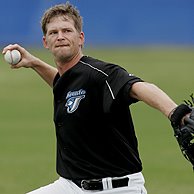The Pessimist's Club
"I don't think you're going to win this division on $70 million. I don't think you're going to make the playoffs in this division on $70 million. You can be competitive and I think you can have some good years. But I just think those two teams, with what they drive payrolls, it's going to be really tough to catch those guys if we stay at a $70 million payroll. It doesn't mean we can't be good and we can't compete. But I just don't think you're going to see a chance to win 95 to 100 games."I didn't catch the whining on Friday, but I couldn't resist a belated response. JP Ricciardi has apparently found a copy of Bud Selig’s six-year-old notes on Competitive Balance, and decided that it’s not possible to make the playoffs when your player budget is ranked 16th in the league. That’s hard news for the Jays – and even worse news for the 14 teams bringing up the rear.
– Toronto Blue Jays General Manager JP Ricciardi in Friday's Toronto Star.
The myth that you need to be at the top of the spending heap to make the playoffs has been debunked time and again. But with baseball’s two most profligate franchises in the same division, do the Jays, Rays and Orioles have a special case to make?
The short answer, I think, is “no.”
After the sunny optimism of April, I can understand why Ricciardi and Jays fans everywhere are frustrated and upset. But it’s just not correct to say that you can’t make the playoffs from the AL East because the budget’s only $70 million. And if that were true, why watch next year?
Toronto had the players necessary to win. But they suffered injuries and under-peformance from key players (mainly pitchers) that undermined their ability to win. Consider the batting, pitching and total VORP figures for the top-ten position players on the following teams, and the top-six pitchers.
AL Division leaders
NYA: 302/158/460
DET: 166/199/365
OAK: 102/164/266
Current AL wildcard leader
MIN: 212/202/414
Other notables:
TOR: 232/148/380
BOS: 223/140/363
CHA: 247/131/378
There are a lot of conclusions you could draw from this information. You might, for example, seek to explain Oakland’s success by observing that VORP doesn’t value defense. Or you might suggest that greater weight should be given to the rest of the roster (including players with negative VORPs who drag down performance) when considering team performance.
But the simplest and most important conclusions should be obvious:
- It's fair to say that this year at least you don't need as much production from elite players to win the AL Central and West as you do to win the AL East;
- In terms of the level of production required from the top-16 players, it's entirely reasonable to say that both Toronto and Boston were within shooting distance of the wild card.
 Roy Halladay and BJ Ryan were every bit as good as promised; but AJ Burnett has only now crossed the 100 innings mark, and his 4.31 ERA / 15.4 VORP put him a level below the elite pitchers of the American League. Regular starters Marcum, Chacin and Janssen aren’t even at replacement level production, and Josh Towers (VORP minus-18.8 in 54 IP) has the dubious distinction of being the worst pitcher in the American League. We can offer some commiseration that his BABIP was a lofty .355, but he didn’t help matters with his miserable strikeout and walk rates.
Roy Halladay and BJ Ryan were every bit as good as promised; but AJ Burnett has only now crossed the 100 innings mark, and his 4.31 ERA / 15.4 VORP put him a level below the elite pitchers of the American League. Regular starters Marcum, Chacin and Janssen aren’t even at replacement level production, and Josh Towers (VORP minus-18.8 in 54 IP) has the dubious distinction of being the worst pitcher in the American League. We can offer some commiseration that his BABIP was a lofty .355, but he didn’t help matters with his miserable strikeout and walk rates.Boston fared a bit better, with adequate performances from Wakefield, Beckett and Lester (get better!), and superlative years from Schilling and Papelbon. But in the 44 starts they secured from Snyder, Wells, Jarvis, Gabbard, Pauley, Dinardo, Clement and Johnson they managed a VORP of -13.2. Only the fifteen games from Snyder, Wells and Jarvis were in positive territory. That’s not bad in some ways, but starting 29 of 139 games with below-replacement-level pitching is not what’s expected on a $120 million budget.
Neither Boston nor Toronto had offences that were Yankee-good, but to win the wild card they didn’t need to be. And both were better than Minnesota.
As of today, the Twins are poised to make the playoffs on a budget of $63 million. Oakland is doing it on $62 million; Detroit required $82.6. The White Sox are contending on a $103 million budget, but aren't discernibly better (pre-injury) than the Twins. Best of all, Florida is two games back of the NL wildcard on a budget of $15 million. So quit yer whining, Ricciardi! And to Florida, and the others who demonstrate that brains can beat deep pockets: Godspeed.



1 Comments:
You know very well that the only reason that Florida and its $15 million payroll remains in contention is because the rest of the National League, save the Mets, is so mediocre. If the fish played in the AL, they would have been out of the playoff race weeks ago.
Now, having said that, you're right. Ricciardi is a whiner. He should have saved his $55 million for a pitcher who has proven that he can go for longer stretches than 30 innings without going on the DL.
If he doesn't have the money to turn his team into a winner, it's because he spent it in the wrong places.
Post a Comment
<< Home